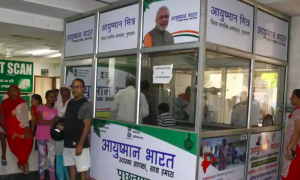The India of naked, hungry, and homeless, teeming millions is all but gone. But India must promote the orderly development of its entire health system and address many of the challenges that it now faces.
There are some interesting developments in progress within India. Extreme poverty is all but gone and by 2025 the prediction is that fewer than 1% of the population will be at that level of income. With the total fertility rate nearing replacement rate, population growth rate has slowed sharply and is expected to fall below 1% per annum by 2025, with several states already showing negative rates of growth. Total calorie consumption has fallen and there are now consistent food surpluses in the country. While each of these statistics is individually remarkable, taken together they paint a picture that is very different from the one that India woke up to on August 15, 1947. The India of naked, hungry, and homeless, teeming millions is all but gone forever, as are the fears of Professor Malthus, one of the earliest teachers of Indian civil servants at the East India Company College in Hertfordshire. As India looks ahead and prepares itself for the next decade, it will need to make room for this new India, and to think very differently than it has in the past.
This new India faces some very different challenges. Very few people below the poverty line but close to 95% of the population being low-income, and not middle-class. Adequate total expenditure on health care by citizens but over 50 million people returning to poverty each year because of health shocks, having to once again claw their way back up. And, despite all this expenditure, a continuing burden of maternal and child mortality and infectious diseases alongside a rapidly rising burden of non-communicable diseases such as high blood pressure, diabetes, and mental illness which have a direct impact on the well-being and economic productivity of young Indians. Absolute hunger a distant memory for families but children with high levels of anaemia and malnutrition which hurts both their physical health and their mental abilities. To respond effectively to these new challenges, India may need to focus its attention and redirect its scarce tax resources towards building up its human capital and rely far more heavily on its well-functioning capital markets and private sector, to address the more traditional challenges of the lack of adequate capital and infrastructure and tools for risk management in the economy,
In a field such as curative health care , given the severe challenges that are inherently associated with it and its strong links to the productivity and welfare of its citizens, countries which have built well-functioning health systems have done so by strongly shaping and controlling their health care markets using all the tools at their disposal, and by so doing have effectively addressed the four concerns of health status, degree of responsiveness, financial protection, and equity. They have all, for example, used taxes (and other tax-like mandatory instruments) as the primary means of pooling current health care expenditures of citizens (currently estimated at over 4% of GDP for India) and have then used these pooled funds to pay for health care , instead of requiring their citizens to pay for them from their pockets when they need to use them. Additionally, all of them have found a way of keeping a strict control on both the quantity and quality of health care that is provided using a combination of their pooled purchasing power and the more traditional licensing and price control regimes, and have not allowed market forces to determine them in an unfettered manner.
India, while continuing on its journey to further strengthen its public health system, may also want to explore these ideas more carefully, to promote the orderly development of its entire health system and to address many of the challenges that it now faces. For example, in addition to allocating a significantly larger share of its annual tax budget for health care as many countries with similar aspirations have already done, it could also further strengthen its commercial health insurance markets and work closely with it to introduce products far more suitable for low-income families. It could also use schemes such as Employees’ State Insurance Scheme and Ayushman Bharat to garner additional resources from the public and in return offer all of them free and high quality health care . Additionally, while India could, over time, further strengthen its capacity to regulate the health care sector, since it already has a great deal of experience in operating strict licensing and price control regimes, it could very rapidly and effectively bring this to bear in health care markets.
























 WhatsApp us
WhatsApp us
Pingback: 바카라사이트
Pingback: kalpa pharma europe
Pingback: شات كتابي
Pingback: hkpools
Pingback: Dylan Sellers
Pingback: huong dan dang ky 12bet
Pingback: w88
Pingback: old facebook design
Pingback: Dumps With Pin Shop 2020
Pingback: bitcoin evolution
Pingback: cvv full
Pingback: 토토사이트
Pingback: rolex replica
Pingback: Digital Transformation
Pingback: buy clenbuterol online
Pingback: wigs
Pingback: Whynter WC-28S manuals
Pingback: CI-CD
Pingback: 토토사이트
Pingback: it danışmanlık
Pingback: track1&2 shop
Pingback: wholesale sex dolls
Pingback: replica rolex best clones
Pingback: why not look here
Pingback: nova88
Pingback: sbo
Pingback: สล็อต pg เว็บตรง
Pingback: magic mushroom chocolate bar usa
Pingback: Devops as a Service
Pingback: mushroom chocolate bars for sale
Pingback: pour apprendre plus
Pingback: read more here
Pingback: mushroom microdosing benefits
Pingback: toronto cannabis delivery
Pingback: uk magic mushrooms identification